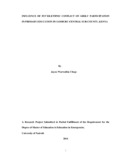| dc.description.abstract | This study investigated the influence of inter-ethnic conflict on girls’ participation in
primary education in Samburu Central Sub-County, Kenya. The research was guided by
the following objectives: To establish the extent to which violence; displacement;
destruction of schools’ physical facilities influences participation of girls in primary
education in Samburu. It also sought to establish the coping mechanisms of primary
school girls’ in Samburu Central Sub- County if any and also find out the ways in which
their participation could be improved. It adopted a descriptive survey research design.
The target population was all the 20 primary schools in Samburu Central Sub-County,
with 20 head teachers, 370 teachers and 1050 pupils. The study used all the schools thus
all the 20 head teachers participated. Simple random sampling was used to sample 30%
of the teacher and pupils thus 135 teachers and 315 pupils were the research sample.
Questionnaires were used to collect data from the respondents, while collected data was
analyzed both qualitatively and quantitatively.
The research findings revealed that majority of the respondents, 55.6 percent head
teachers, 53.7 percent teachers and 72.9 percent pupils indicated that the area is affected
by inter-tribal conflicts from time to time that interfere with the livelihoods of the
residents. All the respondents indicated that girls in their schools had been attacked on
their way to school, confirming the prevailing insecurity in Samburu County that is likely
to influence girls’ participation. Nevertheless, girls drop out of school after being
attacked on their way to school, while those that still continue with education have
lowered academic performance and self-esteem, revealing that girls are more vulnerable
during conflict than boys thus reducing their participation.
The study further revealed that displacement affects the participation of girls in primary
education negatively as schooling schedules are interrupted when families move to
safety. The teachers suggested that girls are safer in school thus construction of boarding
schools was highly recommended by majority of teachers, 53.2 percent, since pupils will
remain in the secure enclosure of the school thus protecting them from insecurity as they
commute to and from home. All the heads of the schools indicated that their schools have
been affected , in one way or the other during the inter-ethnic conflicts by suffering losses
as classes are burnt, school supplies looted and books destroyed. When school facilities
and resources are destroyed, learning during and after conflict is disrupted thus
participation is lowered. Destruction of school facilities and displacement comes hand in
hand since school structures are worst destroyed by fleeing families and schools are not
capable of repairing destroyed structures, thus learning is crippled.
The findings of the study concluded that gender inequality which is deep rooted in the
society exclude girl child from education though security is the platform for all other
problems that hinder participation in education especially for the plight of the girl child.
In the light of the study findings and conclusions the study recommended that; the
government should put in place measures to intensify security in the region especially
through disarmament of illegal weapons, and also put up police posts to fight the rising
security threats. Sensitization of the public on the importance of community unity in
national levels would reduce inter-tribal conflict since the communities will regard
members of other ethnic tribes as fellow citizens. The researcher proposes further
research on the contribution of boarding school program on girl participation in
education | en_US |

